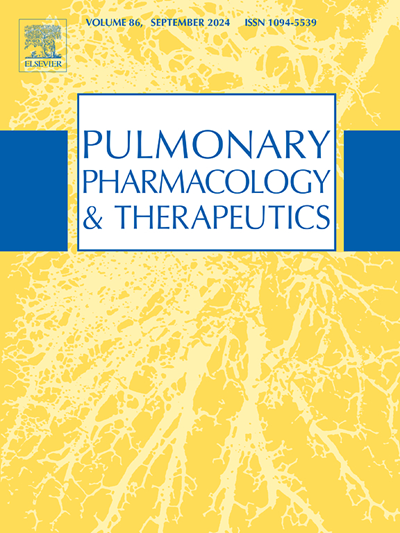在加压计量吸入器中切换到低全球变暖潜势推进剂时对二丙酸倍氯米松药代动力学的影响。
IF 2.8
3区 医学
Q2 PHARMACOLOGY & PHARMACY
引用次数: 0
摘要
导语:用于加压计量吸入器(pmdi)的高全球变暖潜能值推进剂(如HFA-134a)正在逐步减少。二丙酸倍氯米松(BDP)通过HFA-134a推进剂pMDI在多个国家被批准用于治疗哮喘。这是重新配方使用低全球变暖潜势推进剂HFA-152a。两项研究比较了HFA-152a和HFA-134a通过pMDI给药的BDP药代动力学。方法:两项研究(N=71/项研究)均为单剂量(四次吸入BDP)、随机、双盲、交叉(研究1,四路;研究2(双向),在健康志愿者中。在研究1中,受试者通过HFA-134a pMDI吸入BDP分为两个阶段(一个阶段为200 μg/驱动,另一个阶段为100 μg/驱动),另外两个阶段为HFA-152a pMDI(200或100 μg/驱动)。在研究2中,受试者使用间隔装置通过HFA-134a或HFA-152a pMDI吸入BDP 200 μg/驱动。比较含有HFA-152a和HFA-134a的pmdi的肺可用性(BDP比较)和全身暴露总量(倍氯米松-17-单丙酸比较[B17MP;最大血药浓度(Cmax)几何平均比值与血药浓度-时间曲线下面积(AUC0-t)的90%置信区间(CIs)在80-125%之间,即判定生物等效性。结果:无间隔剂(研究1)和加间隔剂(研究2)两种BDP 200 μg制剂的Cmax和AUC0-t相当,BDP 100 μg AUC0-t符合生物等效性标准,但Cmax下90% CI略低于生物等效性限值(79.46%)。在所有三个比较中,B17MP Cmax和AUC0-t与两种推进剂生物等效。结论:总体而言,HFA-152a和HFA-134a在有或没有间隔剂的情况下对BDP 200 μg/驱动具有生物等效性。虽然对于BDP 100 μg,这两种制剂的生物等效性不能正式得出结论,但最小的差异表明这两种制剂可以被认为是治疗等效的。本文章由计算机程序翻译,如有差异,请以英文原文为准。
Impact on beclometasone dipropionate pharmacokinetics when switching to a low global warming potential propellant in a pressurised metered-dose inhaler
Introduction
Use of high global warming potential propellants (e.g., HFA-134a) for pressurised metered-dose inhalers (pMDIs) is being phased down. Beclometasone dipropionate (BDP) is approved for the treatment of asthma in several countries via an HFA-134a propellant pMDI. This is being reformulated using the low global warming potential propellant HFA-152a. Two studies compared BDP pharmacokinetics delivered via pMDI using HFA-152a vs HFA-134a.
Methods
Both studies (N = 71/study) were single-dose (four inhalations of BDP), randomised, double-blind, crossover (Study 1, four-way; Study 2, two-way), in healthy volunteers. In Study 1, subjects inhaled BDP via HFA-134a pMDI in two periods (200 μg/actuation in one period, 100 μg/actuation in the other) and HFA-152a pMDI in the other two (200 or 100 μg/actuation). In Study 2, subjects inhaled BDP 200 μg/actuation via HFA-134a or HFA-152a pMDI using a spacer device.
pMDIs containing HFA-152a and HFA-134a were compared in terms of lung availability (BDP comparisons) and total systemic exposure (beclometasone-17-monopropionate comparisons [B17MP; active metabolite of BDP]), with bioequivalence concluded if the 90 % confidence intervals (CIs) of the geometric mean ratios of maximum plasma concentration (Cmax) and area under the plasma concentration–time curve between time zero and the last quantifiable timepoint (AUC0–t) were between 80 and 125 %.
Results
BDP Cmax and AUC0-t were equivalent for the two BDP 200 μg formulations, without (Study 1) and with spacer (Study 2). BDP 100 μg AUC0-t met the bioequivalence criteria, but the Cmax lower 90 % CI was marginally below the bioequivalence limit (79.46 %). B17MP Cmax and AUC0-t were bioequivalent with both propellants in all three comparisons.
Conclusions
Overall, bioequivalence was confirmed of HFA-152a and HFA-134a for BDP 200 μg/actuation, with and without a spacer. Although bioequivalence of the two formulations cannot be formally concluded for BDP 100 μg, the minimal difference suggests the two formulations can be considered therapeutically equivalent.
求助全文
通过发布文献求助,成功后即可免费获取论文全文。
去求助
来源期刊
CiteScore
6.20
自引率
0.00%
发文量
41
审稿时长
42 days
期刊介绍:
Pulmonary Pharmacology and Therapeutics (formerly Pulmonary Pharmacology) is concerned with lung pharmacology from molecular to clinical aspects. The subject matter encompasses the major diseases of the lung including asthma, cystic fibrosis, pulmonary circulation, ARDS, carcinoma, bronchitis, emphysema and drug delivery. Laboratory and clinical research on man and animals will be considered including studies related to chemotherapy of cancer, tuberculosis and infection. In addition to original research papers the journal will include review articles and book reviews.
Research Areas Include:
• All major diseases of the lung
• Physiology
• Pathology
• Drug delivery
• Metabolism
• Pulmonary Toxicology.

 求助内容:
求助内容: 应助结果提醒方式:
应助结果提醒方式:


